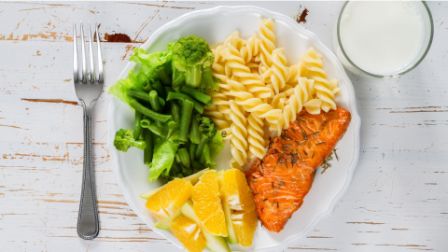Back in the day, eating was a means of survival but right now, with the vast number of fast-food shops and restaurants, we tend to overindulge in eating. Sometimes, due to our busy schedule, we even tend to skip the entire meal as such. So, when there is an over or under consumption of food, the calorie intake also fluctuates. This means that our body does not receive the correct amount of energy needed to fulfil day-to-day tasks.
However, there are numerous ways to keep your calories intake in check. In this article, we will be discussing a few of them so that you can lead a healthy lifestyle.
Ways to keep your calories intake in check
1. Calculate your calorie

Let us start from the first step to keep your calories in check – check or calculate your calories to know if you are having too much or too little. Calories can be calculated using three different equations – Mifflin-St Jeor Equation, Harris-Benedict Equation, Katch-McArdle Formula.
Mifflin-St Jeor Equation is the most accurate one while calculating BMR (Basal Metabolic Rate) while Katch-McArdle Formula for calculating the Resting Daily Energy Expenditure (RDEE). The formulas for each are given below –
Mifflin-St Jeor Equation –
- Men – BMR = 10W + 6.25H – 5A + 5
- Women – BMR = 10W + 6.25H – 5A – 161
Revised Harris-Benedict Equation –
- Men – BMR = 13.397W + 4.799H – 5.677A + 88.362
- Women – BMR = 9.247W + 3.098H – 4.330A + 447.593
Katch-McArdle Formula:
BMR = 370 + 21.6 (1 – F) W
Where,
- W is body weight in kg,
- H is body height in cm,
- A is the age of the person,
- F is body fat in percentage.
2. Use a calories intake app
If you find that calculating calories is difficult and time-consuming, you can also use apps and trackers to calculate your calorie intake. These apps help calculate your calorie intake and give you daily tips and tasks to motivate you to have a healthy, well-balanced diet and do exercise. One such helping device is a fitness band as it tracks your workout and sleep, monitor heartbeat, and provides daily tips as motivation.
3. Reducing the amount of sauce intake
Do you take mayonnaise and ketchup with your French fries? You must be thinking that these sauces will not contribute to your calorie intake, but this is not the case! About one teaspoon of mayonnaise contains around 57 calories. Mind you – this is one teaspoon; most people consume more than one teaspoon so just imagine the amount of calories intake in just one meal.
4. Reduce sugar-sweetened drinks
Sugar-sweetened drinks are soda, coke, sprite, etc. and other commercial drinks like coffee, fruit juice, and smoothies hike the sugar level in your blood. Just like sauces, we often skip soft drinks as a means of calorie intake. Did you know that a 475ml bottle of coke contains nearly 200 calories and 44 grams of sugar?
So these types of drinks result in a higher chance of obesity and type 2 diabetes and increase your appetite and calorie intake. To reduce the calorie intake in your morning drinks, you can also reduce the sugar content in your tea and coffee, as one teaspoon of sugar contains about 16 calories in your drinks.
5. Avoid junk food whenever possible

If you stock junk food in your house, this would be the number one reason your calorie intake is high. Given below are a few junk foods along with their calorie intake –
- Pizza – 200 to 1136 calories
- Hamburgers – 470 to 770 calories
- Chicken strips – 310 to 440 calories
- Burritos – 390 to 950 calories
- Donuts – 200 to 420 calories
Avoid these fast foods whenever possible as it is unhealthy for you, especially if you are someone who stress-eats.
6. Water before any meal
This idea is that if you consume water before your meal, your tummy is full, which means you will eat less. According to a study, when you drink two cups of water, calorie intake will reduce about 13%, thus helping in weight loss.
7. Plate size matters

When you use a large plate, you tend to fill up the flat, which leads to overeating. According to a study, people who use larger plates consume about 45% more than people with smaller plate sizes. So, if you want to cut down on your calorie intake, eat using smaller plates. Another thing most people do is that they try to finish everything on their plate. Eat mindfully, i.e., do not finish everything on your plate if you are not hungry.
8. Substitute proteins instead of calories
Protein is not just healthier, but it also makes you feel fuller. Protein also helps to increase the metabolism rate, which means that a protein-rich diet burns at least 80-100 calories. Besides, protein has many benefits like muscle strengthening, regulating blood pressure and heart diseases, and lowering LDL levels and inflammation. Also, swap your unhealthy meals for healthier ones to reduce the calorie content.
9. Avoid second servings

If your meal is delicious, higher chances for second servings. Avoid these second servings, especially if you are full, as this can increase your calorie intake. Choose a reasonably sized portion, even if you are using a small or large plate.
10. Eat whole fruits
Whole fruits contain more nutrients, fibres, vitamins, minerals, and antioxidants but only fewer calories. Another perk is that we cannot overeat whole fruits. So instead of having fruit juices, switch to whole fruits.
Verdict –
When our body breaks down the food for absorption and digestion, there is the energy released in the form of calories. But when excess calories are consumed, our body stores it as body fat which is unhealthy for your body. So, it is essential to calculate your calorie intake and to keep it in check.
Do you know any other ways to keep your calories in check? If so, do let us know in the comment section below.


